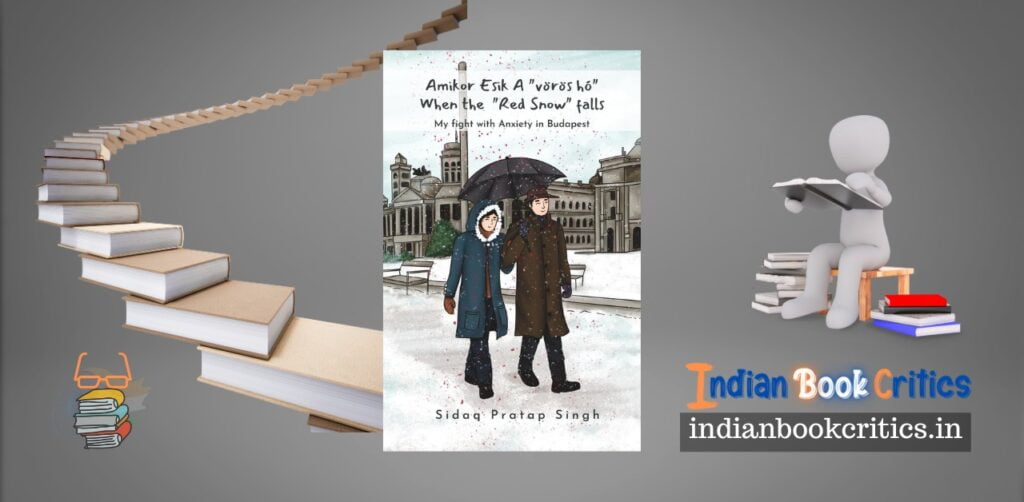Title: When the “Red Snow” falls: My fight with anxiety in Budapest
Author: Sidaq Pratap Singh
Language: English & Occasional Hungarian
Publication Date: 2024 (First)
Publisher: Notion Press
ISBN: 9798894158693
Genre: Memoir, Autobiography
Page Count: 110
Format: First-person Narrative
There are moments in a book reader’s life that change perspectives. Sidaq Pratap Singh’s thought-provoking book Amikor esik a “vörös hó”—When the “Red Snow” Falls in English—made me think about many things I seldom cared about. The book’s subtitle is far more critical: “My fight with Anxiety in Budapest.” Essentially, the book is about Sidaq’s struggles for being an Indian in Budapest. His professors, a few of them he mentions in this book, people at large, the institution itself, and others racially attacked the author on many occasions. The author introduces email exchanges, complaints, accounts and details of discrimination and racial abuse in the book. Moreover, the book also covers a few other aspects of Hungary. It throws light on their film-making culture, the 2021 anti-LGBTQ law and protests, the conflicts with “Roma thief”, and their struggles in other walks of life.
The book has twenty chapters. It begins with the cause itself, the cause that brought the author to Budapest in the first place: cinema. Sidaq Pratap Singh reached Budapest to study film-making in 2018. However, the venture might not have been the desired way for the author. Readers can notice the anxiety, discomfort and problems of finding themselves away from home from Chapter 3 onwards. The details appear to ascend from less severe to critically severe as readers navigate the chapters. For example, in the ninth chapter, the author discusses his thoughts on attempting suicide.
“Thinking of all this, I thought of committing suicide. I thought for days about whether I should die by jumping into a river or jumping off a mountain. I also googled which one of these deaths is less painful.”
(Sidaq 44)
With these details, there are also the photographs in the book. Most of the time, these photos accompany the mental and emotional state of the author. The anxiety of being away from one’s home, the fear of being amidst people who cannot comprehend a person, the experiences of an outsider trying to fit in, and many other details are in the book that Sidaq shares with his readers.
Sidaq shares his experiences and feelings through this journey. He also informs readers about his activities and outings with a few friends. For example, he dedicates a chapter to his visit to a cemetery (ch 11). Personal anecdotes are another distinctive feature of this narrative. Chapter seven, Dance India Dance, presents the author’s humorous yet troublesome predicament. If you read this book, make sure you read the seventh chapter carefully.
Besides his personal predicament and anxious days in Budapest, the author also shares his thoughts on the BLM protests, anti-racism marches, student agitations, and more. With references from movies, allusions to film titles, and recapitulations of fallen heroes from the past, the author describes his understanding of the foreign country that is seldom ready to receive him. However, Sidaq suggests that he has made Budapest his second home, away from home!
There are a few thoughts about Sidaq’s interpretation of events. First of all, like many Indians, the author mistakes the Nazi symbol “Hakenkreuz” as the sacred symbol “Swastika”. “Swastika” symbolises peace, prosperity and harmony, among many others. This news article highlights how the Oregon State’s Department of Education legally distinguishes between the Nazi symbol and the sacred Swastika. Accepting what’s not right and passing it casually in an important book like this unconsciously continues the historical wrongdoing or normalising the mistaken myth that Hitler used the “Swastika” symbol!
Overall, the book, a memoir of the author’s anxious days, is not ‘pleasing’. You may closely associate it with the anxiety of an Indian away from home. However, the writing, narrative technique, presentation of facts and anecdotes, and clever use of the medium of literature to convey thoughts are all well-placed and sharp. Sidaq succeeds in making readers feel his anxiety and suffering. The book becomes a record of his reluctance to accept what he witnesses and an eventual realisation that there are good and bad people everywhere in the world. The ratio, however, might change drastically at times.
Get a copy of the book from Amazon India – click here.
Ashish for Indian Book Critics
